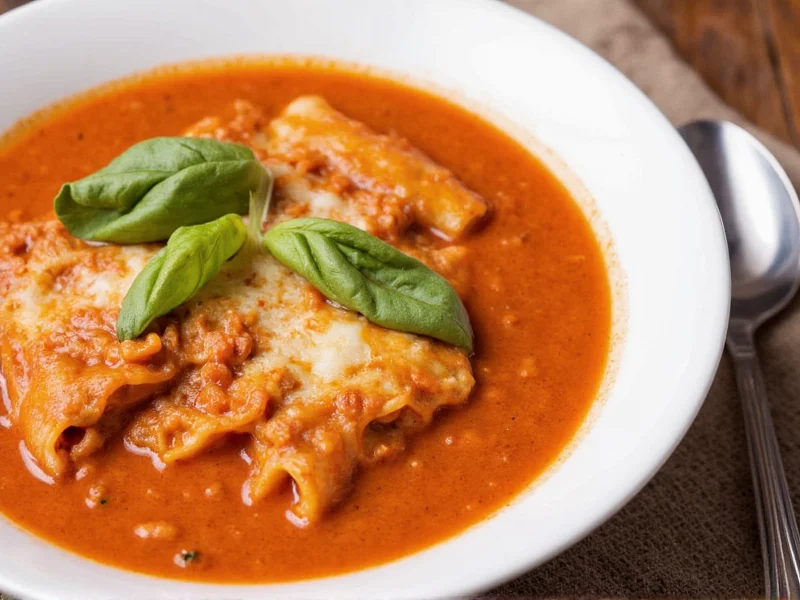The Essential Components of Authentic Lasagna Soup
Creating exceptional lasagna soup requires understanding its foundational elements. Unlike traditional lasagna, this soup version transforms layered components into a harmonious broth-based dish while maintaining signature flavors. The magic happens when quality ingredients meld together during simmering.
Core Ingredients Breakdown
Every memorable lasagna soup starts with these non-negotiable components:
| Ingredient Category | Essential Elements | Quality Indicators |
|---|---|---|
| Tomato Base | Crushed tomatoes, tomato paste, broth | No added sugar, rich color, natural acidity |
| Protein | Italian sausage or lean ground beef | Freshly browned, proper fat content (15-20%) |
| Pasta | Lasagna noodles (broken) or substitute | Al dente texture, no mushiness after cooking |
| Cheese | Ricotta, mozzarella, Parmesan | Fresh, high moisture content, authentic origin |
| Herbs & Aromatics | Fresh basil, oregano, garlic, onion | Vibrant color, strong fragrance, no browning |
Step-by-Step Preparation Guide
Mastering lasagna soup requires precise technique. Follow these professional kitchen methods for restaurant-quality results at home.
Building Flavor Foundations
Begin by browning 1 pound of Italian sausage or ground beef in a large Dutch oven over medium-high heat. Proper browning creates fond—those delicious browned bits that form the flavor base. Drain excess fat but retain about 1 tablespoon for cooking aromatics. Add 1 diced yellow onion and 4 minced garlic cloves, sautéing until translucent (about 5 minutes).
Layering the Broth
Stir in 2 tablespoons tomato paste and cook for 2 minutes to deepen flavor. Add 4 cups low-sodium chicken broth, 1 (28-ounce) can crushed tomatoes, and 1 teaspoon each dried oregano and basil. Bring to a gentle simmer. This creates the rich tomato foundation that defines authentic lasagna soup.
Perfect Pasta Integration
Break 8-10 lasagna noodles into 1-inch pieces and add to the simmering broth. Cook uncovered for 12-15 minutes until al dente. Avoid overcooking—the pasta continues softening as the soup sits. For gluten-free versions, use brown rice lasagna noodles and add them during the last 8 minutes of cooking.
Proven Variations for Every Dietary Need
Adapt this versatile recipe to accommodate various preferences without sacrificing authentic flavor profiles.
Vegetarian Lasagna Soup Transformation
Replace meat with 1 cup cooked lentils and 8 ounces sliced mushrooms. Add 1 diced zucchini during the last 10 minutes of cooking. Boost umami with 2 teaspoons soy sauce or 1 tablespoon nutritional yeast. This vegetarian lasagna soup variation maintains the hearty texture while delivering complex flavors.
Dietary Adaptation Chart
| Dietary Need | Substitution | Flavor Preservation Tip |
|---|---|---|
| Gluten-Free | Brown rice lasagna noodles | Add noodles later in cooking process |
| Dairy-Free | Coconut milk + nutritional yeast | Add cheese substitute at serving |
| Low-Carb | Zucchini noodles (zoodles) | Add raw zoodles to hot soup to preserve texture |
| Spicier Version | Hot Italian sausage + red pepper flakes | Bloom spices in oil before adding liquids |
Professional Chef Techniques
Elevate your lasagna soup from good to extraordinary with these restaurant-tested methods:
- Layering cheese properly: Stir 1 cup ricotta into the soup during the last 5 minutes of cooking. Top individual servings with fresh mozzarella pearls and Parmesan. The residual heat melts cheese perfectly without making it rubbery.
- Acidity balancing: Add 1 tablespoon balsamic vinegar during final seasoning. This brightens flavors and mimics the complexity of slow-simmered tomato sauces.
- Texture control: If soup thickens too much upon standing, revive it with 1/2 cup hot broth. Never add cold liquid to hot soup—it shocks the ingredients and dulls flavors.
Serving and Storage Guidelines
Proper presentation and storage maintain lasagna soup's quality. Serve immediately in pre-warmed bowls to preserve optimal temperature. Garnish with fresh basil ribbons and extra Parmesan. The soup continues developing flavor as it sits—many chefs agree day-old lasagna soup tastes even better as flavors fully integrate.
Store in airtight containers for up to 4 days in the refrigerator. Freeze portions for up to 3 months. When reheating, add a splash of broth to restore ideal consistency. Never boil reheated soup—gentle simmering preserves delicate textures.
Troubleshooting Common Issues
Even experienced cooks encounter challenges with lasagna soup. Here's how to fix frequent problems:
- Too thin: Create a slurry with 1 tablespoon cornstarch and 2 tablespoons cold broth. Whisk into simmering soup until desired thickness.
- Too thick: Gradually add hot broth while stirring until reaching perfect consistency.
- Bland flavor: Balance with 1/2 teaspoon sugar (to cut acidity) plus additional salt and pepper. A Parmesan rind simmered in the soup adds umami depth.
- Mushy pasta: Undercook noodles slightly when first adding to soup. They'll finish cooking in the residual heat.
Frequently Asked Questions
Can I make lasagna soup without meat?
Yes, create delicious vegetarian lasagna soup by substituting meat with 1 cup cooked lentils and 8 ounces mushrooms. Add 2 tablespoons soy sauce or nutritional yeast for umami depth. The soup maintains authentic flavor while being completely meat-free.
How do I prevent pasta from becoming mushy in lasagna soup?
To avoid mushy pasta, undercook lasagna noodles by 2-3 minutes from package instructions. The residual heat continues cooking them after removal from stove. Alternatively, cook noodles separately and add to individual servings just before eating.
What's the best cheese combination for authentic lasagna soup?
The ideal cheese blend includes ricotta stirred into the soup during final minutes, plus fresh mozzarella and Parmesan added when serving. Ricotta provides creamy texture while mozzarella melts beautifully. Authentic Italian Parmigiano-Reggiano delivers the signature salty finish.
How long does homemade lasagna soup stay fresh?
Properly stored in airtight containers, lasagna soup maintains quality for 3-4 days in the refrigerator. Freeze portions for up to 3 months. Many chefs note the flavor improves after 24 hours as ingredients fully integrate. Always reheat gently with added broth to restore ideal consistency.











 浙公网安备
33010002000092号
浙公网安备
33010002000092号 浙B2-20120091-4
浙B2-20120091-4